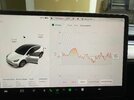Welcome to Tesla Motors Club
Discuss Tesla's Model S, Model 3, Model X, Model Y, Cybertruck, Roadster and More.
Register
Install the app
How to install the app on iOS
You can install our site as a web app on your iOS device by utilizing the Add to Home Screen feature in Safari. Please see this thread for more details on this.
Note: This feature may not be available in some browsers.
-
Want to remove ads? Register an account and login to see fewer ads, and become a Supporting Member to remove almost all ads.
You are using an out of date browser. It may not display this or other websites correctly.
You should upgrade or use an alternative browser.
You should upgrade or use an alternative browser.
Battery health tracking SS
- Thread starter msinfo
- Start date
Please all of you that think you should charge your car from 0 to 30% every day for everyday use. Please write me a for sale listing for your car on how you are going to show me that added value to the car about your charging characteristics.
Not after 10 years but after 3 years when you sell the car because you want a different model and you're trying to claim that your battery was better taken care of, but it still shows the same range as someone that charge to 90% every day.
Not after 10 years but after 3 years when you sell the car because you want a different model and you're trying to claim that your battery was better taken care of, but it still shows the same range as someone that charge to 90% every day.
You are missing the fact that not everything in life is about money or resale value. Sounds like the only thing you are focused on (with your responses here in this thread).Please all of you that think you should charge your car from 0 to 30% every day for everyday use. Please write me a for sale listing for your car on how you are going to show me that added value to the car about your charging characteristics.
Not after 10 years but after 3 years when you sell the car because you want a different model and you're trying to claim that your battery was better taken care of, but it still shows the same range as someone that charge to 90% every day.
I feel like that's where our options are drifting apart. Don't think that this will lead to anything productive, so let's agree to disagree and move on ...
No, I'm really focused on stopping of spreading of disinformation. Someone's napkin base calculations off of old information doesn't do anyone any good service. While we are all are free to manage our car and love it as much as one wants. I am also free to say what I believe is disinformation.
The data being espoused here only makes potential customers wary of batteries and the cars they are in.
There are members of this forum that you can look at and then there are guests. Guests usually are coming here to look at questions and maybe potentially thinking about purchasing a Tesla someday.
So I write this for those people that are coming here. Thinking about buying a Tesla and then they get fed this stuff about leaving their car at 5%. Charging it only to 30%.
I care about promoting sustainable transportation. I'm sorry but I think @AAKEE is doing a disservice to the broader Tesla and EV community by espousing less than up-to-date and factual information.
The data being espoused here only makes potential customers wary of batteries and the cars they are in.
There are members of this forum that you can look at and then there are guests. Guests usually are coming here to look at questions and maybe potentially thinking about purchasing a Tesla someday.
So I write this for those people that are coming here. Thinking about buying a Tesla and then they get fed this stuff about leaving their car at 5%. Charging it only to 30%.
I care about promoting sustainable transportation. I'm sorry but I think @AAKEE is doing a disservice to the broader Tesla and EV community by espousing less than up-to-date and factual information.
zoomer0056
Active Member
FUDthey get fed this stuff about leaving their car at 5%. Charging it only to 30%
Please all of you that think you should charge your car from 0 to 30% every day for everyday use. Please write me a for sale listing for your car on how you are going to show me that added value to the car about your charging characteristics.
I charge to 55% daily. Kept my M3P at 78kWh capacity still after 2.5 years and 66K km. The average same cars at teslafi has three times the degradation.
Also, staying low will reduce the increase of internal resistance that otherwise longterm reduce the power output.
I did not do this for money saving in the first place, I did it for myself.
Why is it so important for you how we use our cars?
I usually wrotes that staying low in SOC is not needed. The battery will hold up for the eight years anyway.
But if one really like to reduce degradation, the most important is to not go by the forum myths. Anyone that like to do this should have the right to it, I guess?
The reason for me to wright about how batteries really work is that the forum is full of myths or ”bullshit” really.
Anyone can use the battery in any way they like, but the most average EV owner shouldnt come here and get biten by the myths.
A very usual question here had been ”My battery already has lost 15% and still I baby it at 80%.
(Not knowing that 80% cause about the same calendar aging as 100%).
I do not tell people how to charge their batteries, I mainly tell people how battery degradation works.
From time to time, on direct questions I help with ”would I do this rather than that?”
Lowest charging setting is 50%So I write this for those people that are coming here. Thinking about buying a Tesla and then they get fed this stuff about leaving their car at 5%. Charging it only to 30%.
I havent really seen a 30% advice.
I think you are overreacting (exaggerating the statements at least).
I think there mostly are very many people happy learning, and complaints are very rare. You’re off course welcome to complain, and I’llread it and take it in, but I can not promise any change.
@AAKEE
Imagine someone said to you that if you change the oil in your ice car every thousand miles, your car will last approximately 6 months longer.
Or
One must fill gas tank and keep it at 25% or higher or it does some type of damage, but maybe not quantifiable. Don't get the dregs of the bottom.
If these thought processes really were true or caught on. Start building the horse barns and start making saddles. People wouldn't stand for it.
Yes statistically it might be true. If you changed your oil more frequently, you'd have less particles in the oil which would make your engine last longer. If you don't get the bottom of the tank, we're all the impurities are maybe your fuel injectors last 6 months longer.
Maybe look at it from a practical application standpoint rather than the 3% of the drivers that think like you do.
Realize that you have a bigger audience than you realize and that your forum posts reflect that you are considered the expert.
My question is it really applicable in modern world for mass EV adoption.
Sure, a car that charges to 100% and is parked 110° garage in Arizona is probably going to have more degradation than the one that charges to 100% inside of a garage in Maine that is 40° after a couple years.
The thing is that both users just have to use their car because they can't just recreate their house to charge in a cool environment and have an envelope around their car in coolness. They have to live in Arizona.
@zoomer0056 surely you can do better. Discussion is always better. Isn't that why this is a forum of ideas and thoughts? I mean come on. A guy that has done over 50 deliveries with strangers and helping build sustainable transportation is a FUD spreader.
Edit add: There are other threads where you basically say charging to even lower than 30% is not a bad thing and you can just do that. My question is is that really a suggestion worth keeping letting the car sit at zero and it's statistically it's not bad and things like that. Think it creates more confusion in the guest not the owner.
Again adoption is more important than the 3% of people that think like you. Clean air or a babied battery for the elite as adoption cratered because people don't understand and don't have PHD's?
Imagine someone said to you that if you change the oil in your ice car every thousand miles, your car will last approximately 6 months longer.
Or
One must fill gas tank and keep it at 25% or higher or it does some type of damage, but maybe not quantifiable. Don't get the dregs of the bottom.
If these thought processes really were true or caught on. Start building the horse barns and start making saddles. People wouldn't stand for it.
Yes statistically it might be true. If you changed your oil more frequently, you'd have less particles in the oil which would make your engine last longer. If you don't get the bottom of the tank, we're all the impurities are maybe your fuel injectors last 6 months longer.
Maybe look at it from a practical application standpoint rather than the 3% of the drivers that think like you do.
Realize that you have a bigger audience than you realize and that your forum posts reflect that you are considered the expert.
My question is it really applicable in modern world for mass EV adoption.
Sure, a car that charges to 100% and is parked 110° garage in Arizona is probably going to have more degradation than the one that charges to 100% inside of a garage in Maine that is 40° after a couple years.
The thing is that both users just have to use their car because they can't just recreate their house to charge in a cool environment and have an envelope around their car in coolness. They have to live in Arizona.
@zoomer0056 surely you can do better. Discussion is always better. Isn't that why this is a forum of ideas and thoughts? I mean come on. A guy that has done over 50 deliveries with strangers and helping build sustainable transportation is a FUD spreader.
Edit add: There are other threads where you basically say charging to even lower than 30% is not a bad thing and you can just do that. My question is is that really a suggestion worth keeping letting the car sit at zero and it's statistically it's not bad and things like that. Think it creates more confusion in the guest not the owner.
Again adoption is more important than the 3% of people that think like you. Clean air or a babied battery for the elite as adoption cratered because people don't understand and don't have PHD's?
Last edited:
zoomer0056
Active Member
You're putting your best out there.@AAKEE
Imagine someone said to you that if you change the oil in your ice car every thousand miles, your car will last approximately 6 months longer.
Or
One must fill gas tank and keep it at 25% or higher or it does some type of damage, but maybe not quantifiable. Don't get the dregs of the bottom.
If these thought processes really were true or caught on. Start building the horse barns and start making saddles. People wouldn't stand for it.
Yes statistically it might be true. If you changed your oil more frequently, you'd have less particles in the oil which would make your engine last longer. If you don't get the bottom of the tank, we're all the impurities are maybe your fuel injectors last 6 months longer.
Maybe look at it from a practical application standpoint rather than the 3% of the drivers that think like you do.
Realize that you have a bigger audience than you realize and that your forum posts reflect that you are considered the expert.
My question is it really applicable in modern world for mass EV adoption.
Sure, a car that charges to 100% and is parked 110° garage in Arizona is probably going to have more degradation than the one that charges to 100% inside of a garage in Maine that is 40° after a couple years.
The thing is that both users just have to use their car because they can't just recreate their house to charge in a cool environment and have an envelope around their car in coolness. They have to live in Arizona.
@zoomer0056 surely you can do better. Discussion is always better. Isn't that why this is a forum of ideas and thoughts? I mean come on. A guy that has done over 50 deliveries with strangers and helping build sustainable transportation is a FUD spreader.
Edit add: There are other threads where you basically say charging to even lower than 30% is not a bad thing and you can just do that. My question is is that really a suggestion worth keeping letting the car sit at zero and it's statistically it's not bad and things like that. Think it creates more confusion in the guest not the owner.
Again adoption is more important than the 3% of people that think like you. Clean air or a babied battery for the elite as adoption cratered because people don't understand and don't have PHD's?
AlanSubie4Life
Efficiency Obsessed Member
He seems to have a RWD Model 3 from 2018 and is probably quoting 291 miles out of the original 310 (94%). Which is 68kWh, down from 77.8kWh, 12.5%.Model 3?
That’s a lot of miles, which vehicle (I could look through posts…). I assume it is a Model 3 RWD? Showing 276 miles or so?Battery university can't explain why I have 11% degradation and someone else has 20%
I prefer to think of it as information but I guess YMMV.I am also free to say what I believe is disinformation.
For me it is not about how long it lasts, it is utility. I want to be able to make long legs between Superchargers. I’m already in a situation where e.g. I have to stop at Inyokern and can’t go from Bishop to Hesperia in most cases. I don’t want to make that worse.your car will last approximately 6 months longer.
Minimizing capacity loss enables longer stretches between Superchargers for a longer portion of the car life.
Is it a huge difference? No. Does it matter? Yes.
Does using @AAKEE ‘s suggestions work? The available evidence suggests yes, so far.
People will have heard about capacity loss on EVs. It’s something they will want to understand.Again adoption is more important than the 3% of people that think like you. Clean air or a babied battery for the elite as adoption cratered because people don't understand and don't have PHD's?
Personally, it’s been very freeing for me to realize that it can be slowed way down with zero impact on my ability to charge the car to 100%. The two are completely compatible in my case. I wish I had known how this worked back in 2018!
I actually think allaying people’s fears about capacity loss with data-driven discussion actually helps EV adoption.
Remember that very little of @AAKEE ’s advice limits the charging of the car, for a typical user. It’s for the most part a recommendation of how to store the battery, not how to use it. You can charge it to 90% or even 100% pretty much as much as you want! Just then drive it, and don’t leave it there.
This is helpful to prospective owners, and it’s not complicated to grasp. It does not require a detailed knowledge of batteries and is as simple as understanding that one should change ICE oil at regular intervals.
Following the advice has also helped get me in the habit of always plugging in at home, something I was sometimes lax about before, and is something that most EV owners should be in the habit of doing (it’s the best part of EV ownership!).
Last edited:
You should look through my previous posts.He seems to have a RWD Model 3 from 2018 and is probably quoting 291 miles out of the original 310 (94%). Which is 68kWh, down from 77.8kWh, 12.5%.
That’s a lot of miles, which vehicle (I could look through posts…). I assume it is a Model 3 RWD? Showing 276 miles or so?
I prefer to think of it as information but I guess YMMV.
For me it is not about how long it lasts, it is utility. I want to be able to make long legs between Superchargers. I’m already in a situation where e.g. I have to stop at Inyokern and can’t go from Bishop to Hesperia in most cases. I don’t want to make that worse.
Minimizing capacity loss enables longer stretches between Superchargers for a longer portion of the car life.
Is it a huge difference? No. Does it matter? Yes.
Does using @AAKEE ‘s suggestions work? The available evidence suggests yes, so far.
People will have heard about capacity loss on EVs. It’s something they will want to understand.
Personally, it’s been very freeing for me to realize that it can be slowed way down with zero impact on my ability to charge the car to 100%. The two are completely compatible in my case.
I actually think allaying people’s fears about capacity loss with data-driven discussion actually helps EV adoption.
Remember that very little of @AAKEE ’s advice limits the charging of the car, for a typical user. It’s for the most part a recommendation of how to store the battery, not how to use it. You can charge it to 90% or even 100% pretty much as much as you want! Just then drive it, and don’t leave it there.
This is helpful to prospective owners, and it’s not complicated to grasp. It does not require a detailed knowledge of batteries and is as simple as understanding that one should change ICE oil at regular intervals.
Following the advice has also helped get me in the habit of always plugging in at home. something I was sometimes lax about before, and is something that most EV owners should be in the habit of doing (it’s the best part of EV ownership!).
2017 model S 250k with 11%
2017 model 3 160k with 8%
Again all I am saying is put all the charging suggestions to a fence sitter on EV's. One won't make the sale.
Wait I have a car that can go 300 miles and you want me to charge to 50% I don't understand says the new person to an EV. Why? Oh because it's good for the battery. Your going to keep the car right? For like 3 years.....Why should I care?
Can't they make the cars so they can go 300 miles? Sure but charging like that high that often leads to faster degradation. What's degradation? Oh it's the amount of battery use you lose each year because of the calendar and your usage. So I want a car that gets a junky battery? Can't I charge it like my cellphone? Oh no. See what happens to your phone? You don't want that do you?
Screw that I am buying another GMC Yukon Denali.
Now, this is very interesting to me! I would love to add a few predictions based on science and knowledge to my charts and see how close/far my battery will be.But I can explain and probably even predict the most probable degradation that your car has.
This is what I need:
What we should check it against is a energy screen calc, as it is commung straight from the BMS Capacity numbers.
You tell me what Tesla you have. Model/year and: MYLR 2023
-Location/average temp: Killington, Vermont 05751. Over the course of the year, the temperature typically varies from 12°F to 81°F and is rarely below -6°F or above 89°F.
-Manufacturing month or purchase month: DOB 2/16/2023 and pick up 3/3/23
-Do you have a garage or is it parked outside? Garage
-Charging level. Daily 50% and I keep it plugged in. Charge for trip varies from 70-90% with couple trips per month typically.
-What SOC (charging level) do you have after a normal day. 42-46%
-When do you charge? Daily (?), at what time does it start. Daily. I just keep the car plugged mostly all the time. When planning on the trip than I use schedule departure.
-Odo reading. 3845
-lifetime average consumption. 308Wh/mi
I also took a few pics.
Attachments
Where do you get the "lifetime average consumption" number from?Now, this is very interesting to me! I would love to add a few predictions based on science and knowledge to my charts and see how close/far my battery will be.
You tell me what Tesla you have. Model/year and: MYLR 2023
-Location/average temp: Killington, Vermont 05751. Over the course of the year, the temperature typically varies from 12°F to 81°F and is rarely below -6°F or above 89°F.
-Manufacturing month or purchase month: DOB 2/16/2023 and pick up 3/3/23
-Do you have a garage or is it parked outside? Garage
-Charging level. Daily 50% and I keep it plugged in. Charge for trip varies from 70-90% with couple trips per month typically.
-What SOC (charging level) do you have after a normal day. 42-46%
-When do you charge? Daily (?), at what time does it start. Daily. I just keep the car plugged mostly all the time. When planning on the trip than I use schedule departure.
-Odo reading. 3845
-lifetime average consumption. 308Wh/mi
I also took a few pics.
AlanSubie4Life
Efficiency Obsessed Member
My intent is not to hector people into buying an EV. There is no need to convince fence sitters!!! We are not trying to “make sales!” There is clearly no need to!You should look through my previous posts.
2017 model S 250k with 11%
2017 model 3 160k with 8%
Again all I am saying is put all the charging suggestions to a fence sitter on EV's. One won't make the sale.
Wait I have a car that can go 300 miles and you want me to charge to 50% I don't understand says the new person to an EV. Why? Oh because it's good for the battery. Your going to keep the car right? For like 3 years.....Why should I care?
Can't they make the cars so they can go 300 miles? Sure but charging like that high that often leads to faster degradation. What's degradation? Oh it's the amount of battery use you lose each year because of the calendar and your usage. So I want a car that gets a junky battery? Can't I charge it like my cellphone? Oh no. See what happens to your phone? You don't want that do you?
Screw that I am buying another GMC Yukon Denali.
People should buy EVs because they work well for their needs.
All we can do is provide the facts, not hide them, as suggested.
You are suggesting that well informed consumers don’t know that EVs lose capacity…which is just not true. I want to inform them that this natural wear can be mitigated and at the same has nearly zero impact on how most owners use the car (it only impacts storage).
Regarding your Model 3: is 8% 8% of 310 miles Model 3 RWD?
(If so that is 14% or so as detailed above.)
For Model S I don’t know how this was handled. Looking at rated mile loss is not a reliable method to use in a general sense - it’s good, but you need more information. Certainly rated miles work similarly on older vehicles but the starting point and how that was dealt with might be different.
Or imagine that lithium batteries might start to behave unpredictable and loose capacity fast at about 20% degradation (20% is the industry standard for end-of-life.@AAKEE
Imagine someone said to you that if you change the oil in your ice car every thousand miles, your car will last approximately 6 months longer.
Also imagine cars closing on the 20% loss after 10 years or so in warm climates, rendering the batteries unpredictable and when people learn about this these cars are ending up un-sellable.
Now imagine you can cut the degradation in half without any real negative effect for yourself if you only charge to the charge level needed until the next charge.
It would be like not withdrawing all money you have on the account at the ATM, instead just withdrawing what you need until the next time.
By cutting the degradation in half, the time until the BMS says ”no more” is doubled.
In Sweden where I live, the average car lives 19.6 years before it is taken from the streets. The average age of all cars is 11.6 years. (Actual statisticts from Sweden).
My high was 317. I am at 296. The earliest 3's were messed around with quite a bit on reserve as you know.My intent is not to hector people into buying an EV. There is no need to convince fence sitters!!! We are not trying to “make sales!” There is clearly no need to!
People should buy EVs because they work well for their needs.
All we can do is provide the facts, not hide them, as suggested.
You are suggesting that well informed consumers don’t know that EVs lose capacity…which is just not true. I want to inform them that this natural wear can be mitigated and at the same has nearly zero impact on how most owners use the car (it only impacts storage).
Regarding your Model 3: is 8% 8% of 310 miles Model 3 RWD?
(If so that is 14% or so as detailed above.)
For Model S I don’t know how this was handled. Looking at rated mile loss is not a reliable method to in a general sense - it’s good, but you need more information. Certainly rated miles work similarly on older vehicles but the starting point and how that was dealt with might be different.
I am very interested in the tracking, and have attributed my S to something similar to what @AAKEE says. However I drove 72,000 miles last year, and 65,000 the year before.
I charge to 90 or more, but the time spent there is negligible because of how much I drive.
I don't think anybody twists people's arms to buy EVs but if you can see from my previous posts which you disagreed on. You can see that I have converted over 50 people to EVs. Unfortunately some of those people gave their referral credits to others. But hey, that's what it is.
I really don't talk much about the S as much as I should, but many people on this forum are now 3 users and the older users are from the old era of bad batteries on the S.
I just think there's a reason why Tesla doesn't publish anything of what you're all talking about. If they did nobody would buy electric vehicles. We can say that the consumer is educated, but we know they're not. Our friends are educated in the world we live in. Everyone that I'm around knows that I'm the EV expert and they come to me when they're considering it. Outside of that, go to a complete stranger and tell them some of the strategies to maintain a battery and they're just not applicable. Maybe if you live in LA or other grid fests.
Most people don't drive their cars for a decade. Most people don't own their cars until they rust out and don't work anymore. I do but again most people don't. So the education that you're creating is confusion I think for many people.
Again in a nice way you called me an outlier. Stats I don't understand on the S. Rated vs not.
3 I don't really care. Looks good to me. I know someone said earlier that the battery range will dictate the price on my model. 3. I strongly disagree with you. If you looked at the rust on my rocker panels, you would say that would dictate the price. And that's what I'm getting at a 10-year-old model. 3. Living in America outside of your California cars. You're probably not going to be looking at too pretty of a car.
My car - TripsWhere do you get the "lifetime average consumption" number from?
Attachments
You tell me what Tesla you have. Model/year and: MYLR 2023
-Location/average temp: Killington, Vermont 05751. Over the course of the year, the temperature typically varies from 12°F to 81°F and is rarely below -6°F or above 89°F.
-Manufacturing month or purchase month: DOB 2/16/2023 and pick up 3/3/23
-Do you have a garage or is it parked outside? Garage
-Charging level. Daily 50% and I keep it plugged in. Charge for trip varies from 70-90% with couple trips per month typically.
-What SOC (charging level) do you have after a normal day. 42-46%
-When do you charge? Daily (?), at what time does it start. Daily. I just keep the car plugged mostly all the time. When planning on the trip than I use schedule departure.
-Odo reading. 3845
-lifetime average consumption. 308Wh/mi
I also took a few pics.
The 82kWh batt varies some during the EPA tests, I took the starting number from the 2023 EPA MYLR Application (end SOC Watt hours, 80.7kWh).
Your low SOC might set you off a little.
I found the annual average temperature for Killington to be about 5C so not that warm. You still had the first halv year covering the hot season so your battery should be be slightly before a simple annual average.
If I do a calc on a higher cell temp/ambient for having the most of the cars life in warmer than your average it says 78.3 kWh.
So you’re on the plan dedpite seeing just a little lower capacity than the calc.
The long term is more interresting, of course.
After 60 months and 10 times the miles you have today you should be looking to this
Awesome - thank you! Would you mind sharing how you did above magic and the math behind it?The 82kWh batt varies some during the EPA tests, I took the starting number from the 2023 EPA MYLR Application (end SOC Watt hours, 80.7kWh).
View attachment 970745
Your low SOC might set you off a little.
I found the annual average temperature for Killington to be about 5C so not that warm. You still had the first halv year covering the hot season so your battery should be be slightly before a simple annual average.
If I do a calc on a higher cell temp/ambient for having the most of the cars life in warmer than your average it says 78.3 kWh.
So you’re on the plan dedpite seeing just a little lower capacity than the calc.
The long term is more interresting, of course.
After 60 months and 10 times the miles you have today you should be looking to this
View attachment 970754
Looks like using remaining capacity of 75.09 at about 5 years old car and 40K on ODO I should be 314 miles range. Or should I use 82kWh starting capacity for 330mi range in my calc?
Last edited:
From @AlanSubie4Life’s charging constant thats 69.3 kWh, so 11% capacity loss from the ”full pack when new” (77.8 kWh) (and also some of the EPA tests).My high was 317. I am at 296. The earliest 3's were messed around with quite a bit on reserve as you know.
I am very interested in the tracking, and have attributed my S to something similar to what @AAKEE says. However I drove 72,000 miles last year, and 65,000 the year before.
I charge to 90 or more, but the time spent there is negligible because of how much I drive.
Reading your posts make me think you have missed quite much of my regular content in the posts?
I very often state that high SOC is not near as bad as the myth. In many cases 80% is tester by research to wear more thN 90-100% (calendar aging wise).
Also doing complete 100-0% cycles (real zero %, not 0% on the screen) has proven to make the Panasonic cells do about 700-750 full cycles. This is equivalent to 700 to 750 times 400 km = about 300.000km or 200K miles.
So, there is absolutely no need to not go to 90 or 100% if needed.
There is also no danger of leaving the battery at 100% overnight. It will not wear noticably more than it would have at 80%.
I had about 35 full charges om my M3P before I sold it after 2.5 years.
For supercharging, which mainly wear by lithium plating, it might be good to know that low SOC and small cycles at low SOC specially have a healing effect on lithium plating after supercharging. Plated Lithium returns to cycleble lithium and the capacity is recovered to some extent.
Similar threads
- Replies
- 18
- Views
- 818
- Replies
- 27
- Views
- 3K
- Replies
- 27
- Views
- 2K
- Locked
- Replies
- 70
- Views
- 6K









